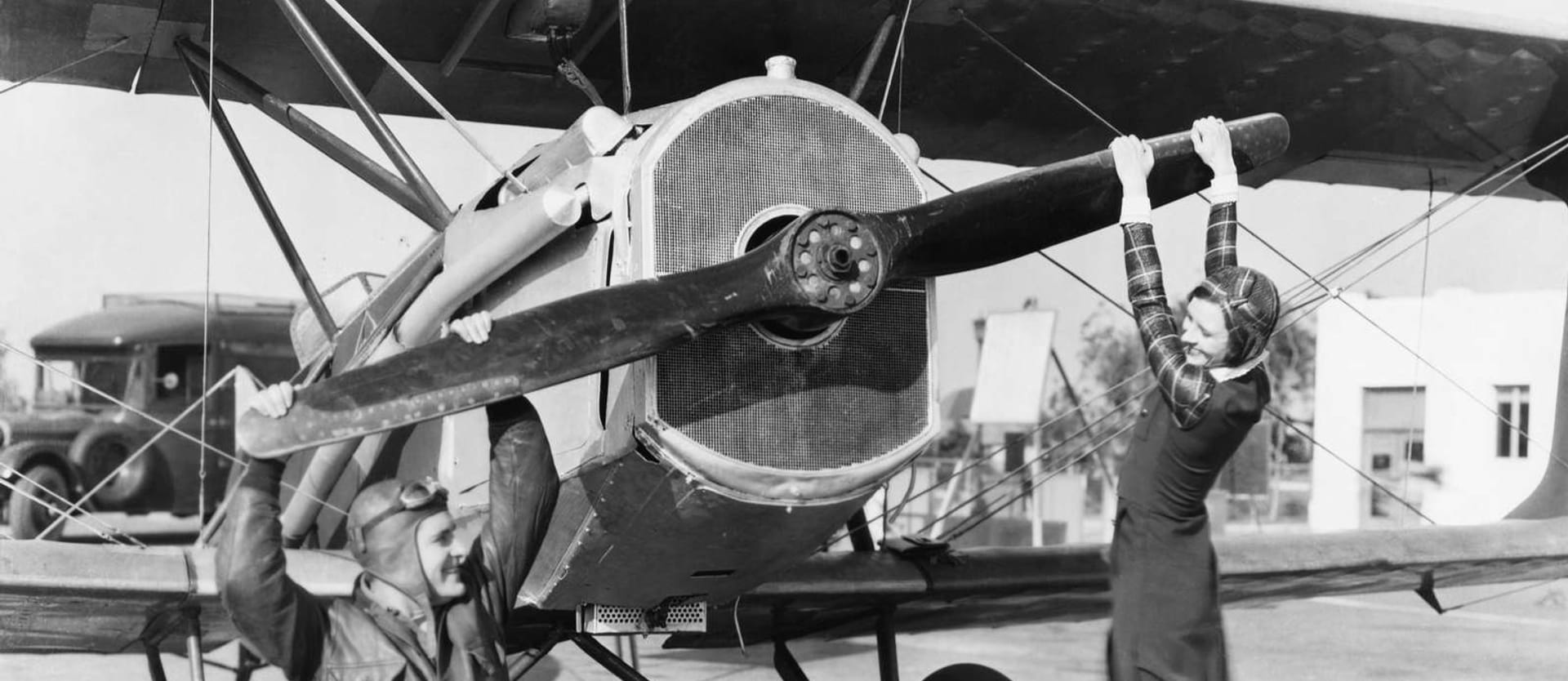This city park in Berlin is one of the most fascinating examples of gentrification. “A crown jewel of open space,” Tempelhoft, a favorite of citizens and tourists alike, was at one time one of the main pre-WW2 airports. The home of Lufthansa, it was constructed back in 1923 and continued operating until 2008. After its closing, Berliners fought hard to keep it as a public space and now, this unique structure houses communal gardens and hosts festivals.
This is the place we would show time travelers to illustrate how the world and our values have changed in 100 years. And how flying became so routine that we often choose to stay grounded.
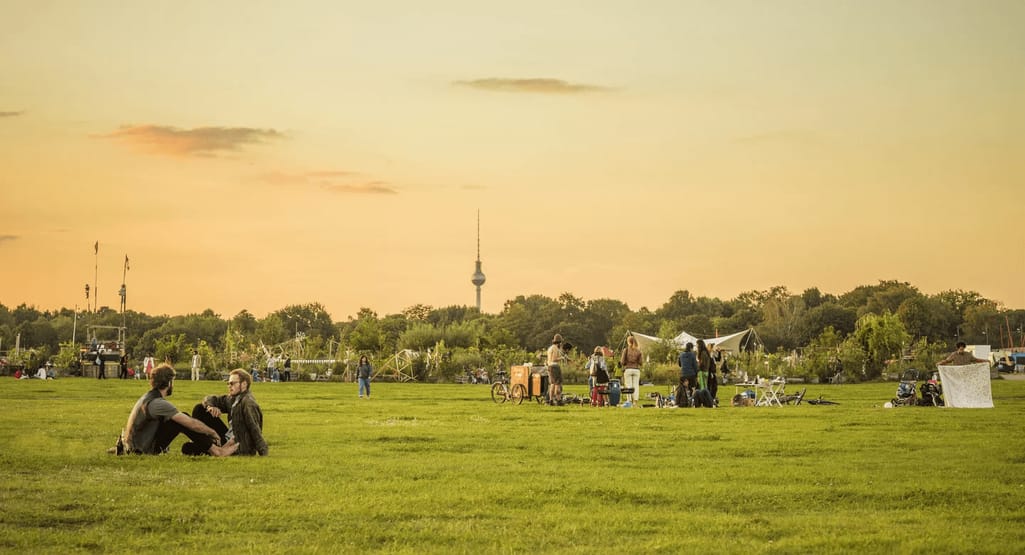
Tempelhof’s 386-hectares have enough space for joggers, cyclists, picnic goers, and dog walkers. Source: visitBerlin.de
Initially, an area called Tempelhof Feld (field in German) quickly grew from a small aerodrome with a hangar to the world’s first airport with an underground railway and a terminal with a contemporary look. Although in the 1920s, air passenger travel was more of an indulgence than a necessity, the construction of an airfield was important for the future growth of the route network.
One hundred years ago, stuck between two wars and on the verge of the Great Depression, the world was optimistic, open to experiments, and hungry for freedom. And the Roaring Twenties delivered. Usually in our special Christmas commentary, we've explored the technology of today and the future. Now, with a new decade approaching, we look into the past. What was it like to experience traveling in the twenties of the 1900s? To board clunky planes, go on the first road trip, or even travel abroad and relax on a cruise ship? Let’s find out.
Vacation is the new normal
To the generation surviving World War I, life in the twenties was entirely new. Aggressive economic growth meant that luxury items were now mass-produced, and a typical middle-class family could afford the most revolutionary product - a car. Henry Ford implemented the 40-hour workweek, which improved the quality of life for a regular factory worker who now had weekends off and could join the consumerist middle class.
While most couldn’t afford a car for a one-time payment, they opted for credit.

General Motors practically invented car credit by offering prestige cars for manageable prices
By the end of the twenties, credit was used to purchase 90 percent of goods. Since splurging was more available and the work schedule became standardized, people were more inclined to take their families on vacation.
The most popular outbound destinations for Americans were the Caribbean, particularly Nassau, Jamaica, or Mexico. At one point, spending time on the beach was so widespread that the suntan went into fashion - a striking contrast to the centuries-old preference for fair skin.
While a car was becoming a common household posession, the most popular modes of transportation for the longest time remained trains and ocean liners.
Railroad - the symbol of the decade
Puffing locomotives, the distinctive sound of train horns, and engineers in overalls tending a firebox are some of the most distinctive images from the golden age of railroading. In the 1920s, trains had already existed for 100 years - about the same time we’ve lived with commercial aviation.
Because of World War II, railroads were nationalized, and the newly created US Railroad Administration invested in new equipment and established numerous changes and standards. A new design for a steam locomotive, an improved signal system, and stronger and quieter cars, made partially from steel (instead of wood), were some of the biggest implementations of the era.
Both in big cities and small towns, railway stations were focal points of community life. They were often the largest and most opulently decorated buildings in the area. Platforms filled with mingling crowds of people from all walks of life had an equalizing effect, while the trains themselves were less egalitaran. Ordinary people traveled on trains seated on simple wooden benches (or two-tier unfolding seats in sleeping cars). In the South until the end of Jim Crow laws, transportation was segregated, while white and black people traveled together in other parts of the country. Well-heeled travelers could afford cushioned cabins, usually designed by professional carpenters.

First-class train cabin with the view on the New Zealand planes
The pinnacle of long-distance travel were the sleeping, dining, and private cars first introduced by George M. Pullman in 1865. He was often invited by carriers to create luxurious cars - elaborately and excessively decorated, with plush seats and expensive chandeliers tinkling in response to the movement. The wealthy enjoyed Pullman cars well into the 20th century. Today, you can find a few Airbnb listings and book your stay in a restored car, now enabled with air conditioning and Wi-Fi.
An interesting detail present in most trains of that era were observation cars - last carriages of the train with a convenient platform for passengers to sightsee.
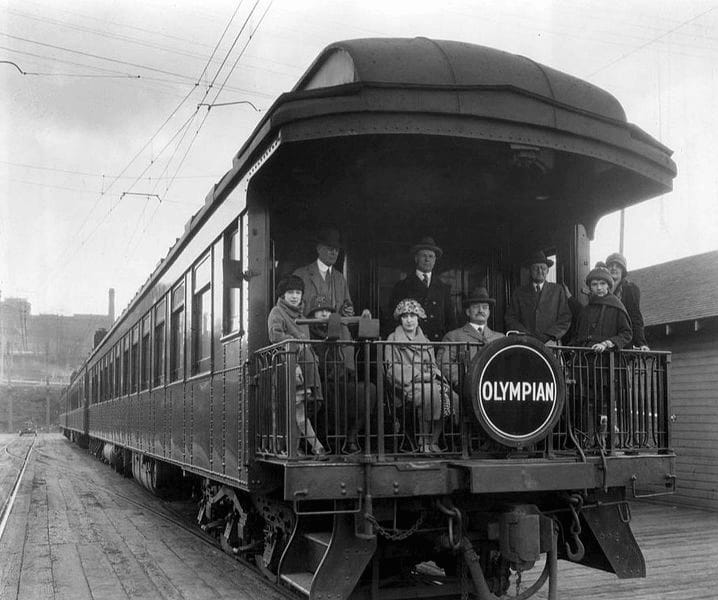
Passengers ready to enjoy the breeze, circa 1927
Prolonging the vacation on a cruise
After the RMS Titanic tragedy of 1912, the maritime standards of safety have been majorly revised and regular lifeboat inspections were introduced. These and many other changes have persuaded the public that sea travel was once again safe. By 1920s, ships and ocean liners became the trendiest mode of transportation. Because of that, the Suez Canal had to be widened to accommodate the increased traffic.

Red Star Line advertisement, 1924. Source: RetroReveries
Transatlantic journeys were advertised as a part of the vacation, offering the wealthiest all types of entertainment from swimming pools to movie theaters. To make room for more people (and sell more tickets), ship decks were divided into different classes, so traveling to and from America got more affordable. Some carriers even introduced the fourth class, promising first-class comfort for a second-class price.

Advertisement depicting newly built spaces for the tourist class including a separate dining room and entertainment options
The prohibition law in the US enabled alcohol-seeking Americans to choose other international carriers, which inherently crippled the US passenger trade. Although the liner companies tried hard to entertain people, spending several days on a ship was still considered boring.
“Auto tourists” and camping
The twenties marked the beginning of the automobile era with the record-breaking Ford Model T selling massively across the country. This was the car that changed the living and traveling of most Americans as it was comparatively cheap and easy to drive. The Tin Lizzie not only provided a bit of privacy (most cars before were open-roofed) but also became a symbol of freedom - now young people could go anywhere anytime, of course, if muddy, country roads allowed.

Camping in Yellowstone. Source: Library of Congress
People were traveling to special events like auto races or carnivals, or simply to the beach. Popular attractions included Luna Parks (amusement parks were a trend of the twenties) in Denver and Coney Island, national parks like Yellowstone and Grand Canyon, the Hollywood Sign (erected in 1923) and the Museum of Modern Art in New York.
As more people took to the road in search of adventure, gas stations, cheap motor hotels (motels), convenience stores, and drive-in restaurants started popping up on the roadsides, shaping the modern American landscape.
The first travel trailers wouldn’t appear until the 30s, but road trippers often stayed at primitive campgrounds, where they put up their own tents. People whose property reached the largest highways would build tourist homes - usually one-story buildings with the most basic services to accommodate people for not more than one night.
The world's first motel opened in 1925 between San Francisco and Los Angeles. It was called Milestone Mo-Tel, charged $1.25 per night, and offered a private bathroom or even a garage in some cases. This was obviously an unseen level of comfort on the road. Before the chain grew across the country, the idea (and the naming) got picked up by lots of entrepreneurs, slowly turning the unique hospitality business into the current bonanza of cookie-cutter rooms.
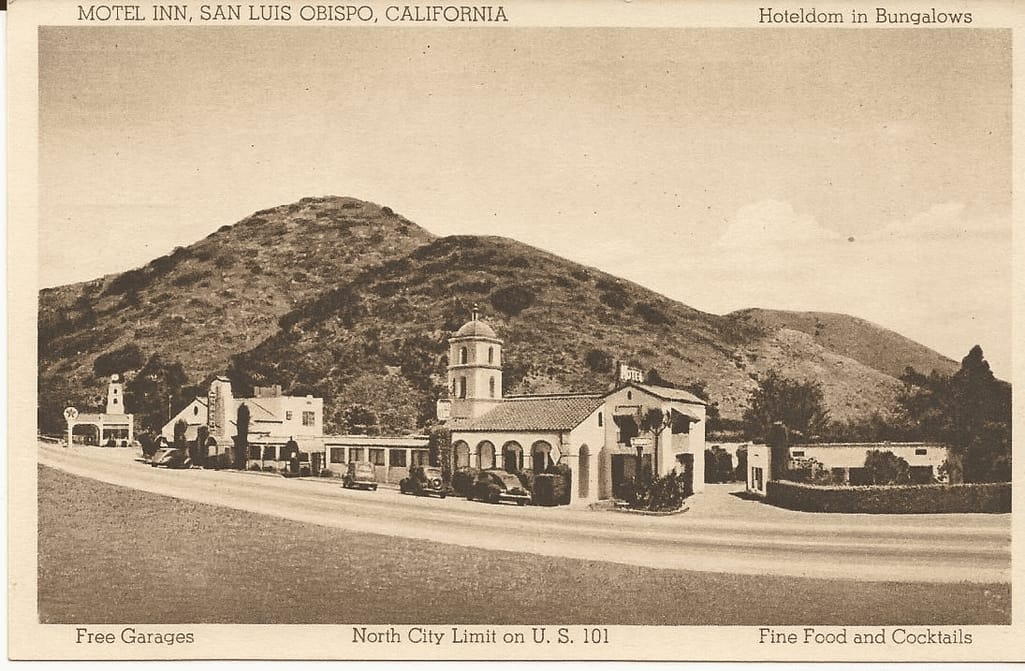
This photo taken between the 1920s and 1930s reveals that Milestone Mo-Tel was almost a luxury location compared to its predecessors
The rare luxury of flying
Although the twenties are considered the beginning of commercial aviation, it was very much on an infancy. The first flight by KLM, the oldest operating airline, took place in 1920. It carried two British journalists from London to Amsterdam. Scheduled flights started running in 1921.

Here pictured Lady Hearth - the first female passenger on a commercial airline
A typical 1920s flying experience was luxurious in a very strange sense. It was expensive - the journey from West Coast to East Coast was about $360 (about $5000 if adjusted for inflation). The legroom was non-existent, the ride was bumpy, and it was cold since most airplane windows were simply holes in the fuselage. It took longer too and in most cases, you couldn’t travel at night. Somewhere in the middle of the flight, you would consider opting for a boat or a train next time.
As for the entertainment, passengers enjoyed food and drinks or watched a movie in an impromptu cinema (on a much rarer occasion). One of the first films shown in the air was The Lost World in 1925 by Imperial Airlines. The video below shows the preparations for the historical screening.
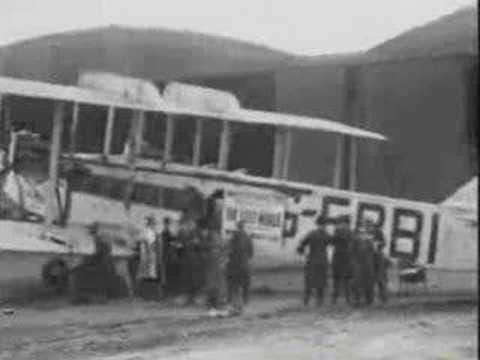

Preparation for watching The Lost World in 1925
The golden age of travel ads
A few years ago, a 1931 poster advertising a French steamship line was sold for nearly £30,000. Such figures are not rare in the world of graphic art collectibles, though you can grab a similar original print on eBay for as low as a few thousand. The famous poster called L’Atlantique was created by one of the most influential graphic artists of the era and the father of the Machine Age style - Cassandre. Bold colors, horizontal lines, and the airbrushed effect replaced the Art Nouveau of the 1890s - the style that started to look out of place in the industrialist, wartime era. Art Deco, famously associated with the twenties, on the whole, dominated art appearing in train stations, window shops of travel agencies, and simply on the streets.
The Machine Age style used prominent angular typefaces, rounded contours, and confident lines
Railway and cruise companies commissioned famous designers like Cassandre, Paul Colin, Tom Purvis, and many others to create images that conveyed the sense of power and safety - basically, what travelers were supposed to feel boarding liners and trains. Travel agencies preferred more lavish details and colorful visuals, especially for exotic destinations like India, Hawaii, or Egypt.
Just like today, traditional ceremonies or spending time in nature were heavily advertised
Experimental and impactful, travel ads were some of the finest artwork of the decade. Although the promised experience was rarely delivered.
The growing industry of travel agencies
People of the 1920s were already avid customers of travel agencies. The oldest one established by Thomas Cook dates back to 1840. It was the first to organize an air tour from New York to Chicago in 1927, advertising the experience of flight rather than a mere mode of transportation.

The tourist group outside a hotel in Cairo
For many, travel agencies were the only guarantee of their safety during the journey. If upper-class travelers had access to personal transit or the help of hotel staff in case of trouble, middle-class visitors had nowhere to turn, especially if they lacked experience or didn’t know the language. Prepaid group tours allowed them to relax. An agent would meet them at the train station or the port, put them on transportation, pay for them, arrange guided tours, and accompany them at every destination.
Some agencies would also publish travel guide books. Thomas Cook’s books were specifically targeted at less urbane travelers of more average means, listing hotels, restaurants, and places of interest available to people of simpler tastes.
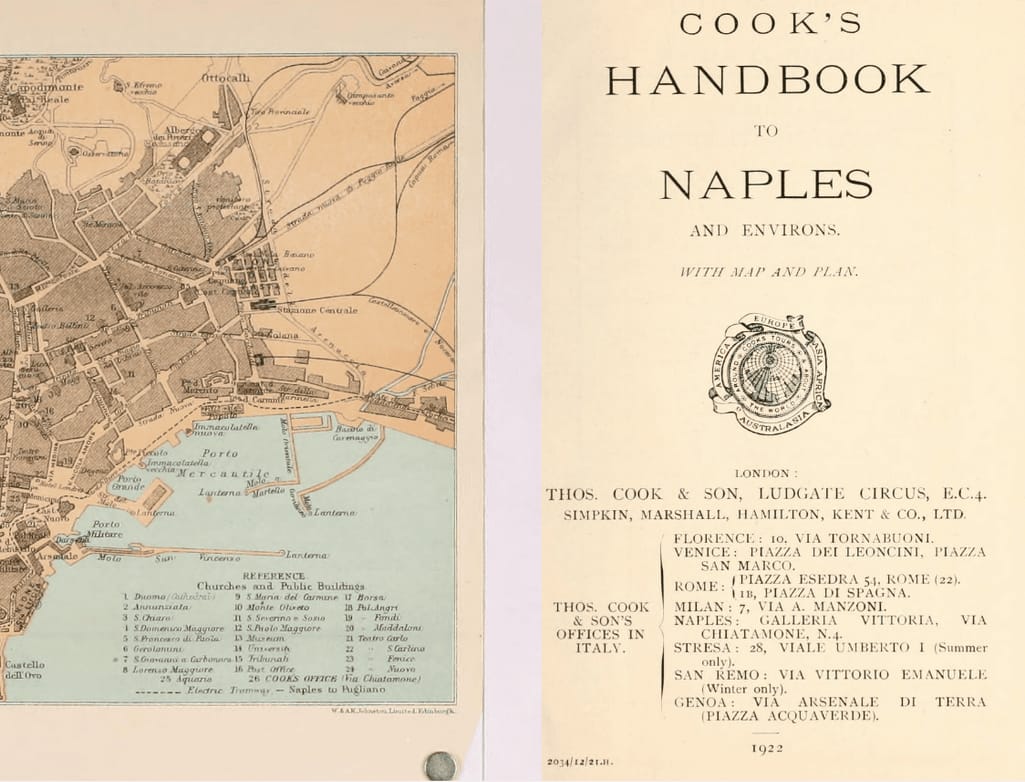
Cook’s travel books were meant to advertise an agency’s services. Source: Archive.org
Today, the appeal of traditional travel agencies remains the same, but the opportunities changed drastically. If in the 1920s people wanted to visit a foreign country, it was simply unsafe to try that alone. In 2020, we want independence and search for authentic experiences. We pack light, follow the advice of Instagram influencers, and get to enjoy long vacations combining beach gateways with work. Is there a way to make travel more convenient? The new decade will show.
1920 vs 2020
The futuristic city presented in 1927’s Metropolis is almost as far from our reality as it was to people 100 years ago. Would it disappoint time travelers from the past? It’s hard to predict how the innovations unfold, but we have at least some advances to boast about. In 2019, Qantas announced its testing of the longest flight in the world - 19 hours of travel between New York and Sydney. It seems like a lot, but it will also take less than a day - in the 1920s and for the decades to come, no ship or plane would have delivered you so fast across land and sea.
Comfort is another advancement though jet lag hasn’t gone anywhere. Prices are cheap even when they’re expensive and getting a ticket is so easy we can book a trip in a few clicks (a concept we would struggle to explain to our 1920s friends).
But the most fascinating parts are not the differences, but how much we have in common, even 100 years apart. It’s the wanderlust, the simple pull to grab a tent and go for a weekend getaway to the Grand Canyon. We are enchanted still by magical (albeit unrealistic) imagery of faraway places. We desire to expand our horizons, meet people around the world, experience new ways, foods, cultures. None of this will change in the next 100 years.

Maryna is a passionate writer with a talent for simplifying complex topics for readers of all backgrounds. With 7 years of experience writing about travel technology, she is well-versed in the field. Outside of her professional writing, she enjoys reading, video games, and fashion.
Want to write an article for our blog? Read our requirements and guidelines to become a contributor.
